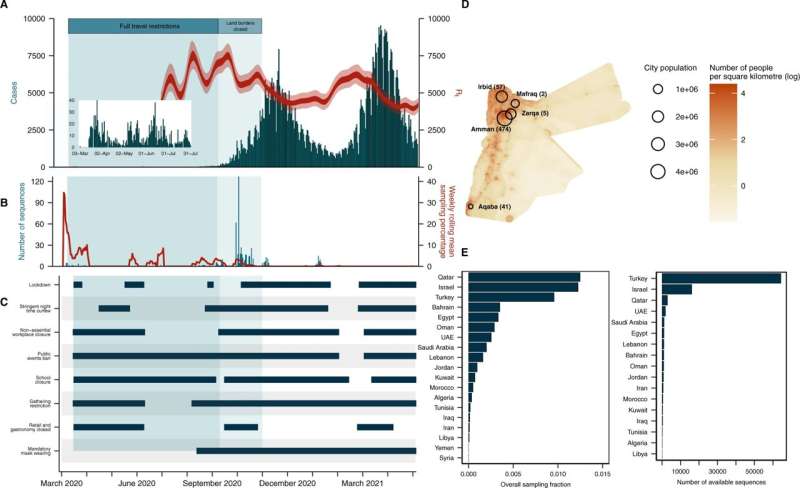Scientists identify how SARS-CoV-2 spreads in the Middle East

Understanding the global transmission of SARS-CoV-2 is critical for rapidly containing and handling the virus, especially as new variants and mutations of concern emerge. Certain regions in the world, including the Middle East and Northern Africa region, have been notoriously understudied and under-sampled. For the first time, Scripps Research scientists and collaborators unveil how the virus spreads in this region to better understand the unique ways that infectious disease threats arise and evolve in the Middle East.
The findings, published on August 15, 2022 in Nature Communications, showed that the strong regional connectivity of the Middle East drove both introduction risk and export risk of the virus—events that mainly stemmed from land-based travel while air travel restrictions were in place. The discoveries highlight the importance of improved pandemic surveillance infrastructure across the entire globe, especially given that transmission dynamics have been obscured by uneven sampling.
"Before the study, it wasn't entirely clear what was driving transmission dynamics in the Middle East, or how these relationships were changing over time in response to measures such as border closures and lockdowns," says Kristian Andersen, Ph.D., a co-author of the study and a professor in the Department of Immunology and Microbiology at Scripps Research. "Our findings illuminate these drivers, and more importantly, the policies that will be helpful in mitigating the virus in this specific part of the world."
The study focused on Jordan, due to its central geography and tight sociopolitical, cultural and economic ties with other countries in the Middle East. From March to September 2020, Jordan banned all non-essential air travel in an effort to mitigate the viral spread, while also implementing a two-week-long quarantine for those who did enter the country.
Working hand-in-hand with Issa Abu-Dayyeh, Ph.D., senior author of the study and head of immunology and research at Biolab Diagnostic Laboratories in Jordan, the researchers integrated genomic, epidemiological and travel data to reveal the key drivers of SARS-CoV-2 transmission from March 2020 to May 2021. They found that regional connectivity was a considerable driver of viral transmission, given that 85% of incoming air passengers from March to early September 2020 were from other countries in the Middle East.
Land-based travel was also a big culprit for introducing new strains of the virus into the country, especially from freight transport. While private land-based travel was limited, incoming truck volume recovered to pre-pandemic levels from July 2020 onwards—suggesting this is where viral introduction stemmed from. Similarly, they also discovered that land travel drove Jordan's exportation of the virus to other surrounding countries.
However, once travel restrictions were lifted in September 2020, viral introductions were then attributed mainly to air travel once again, as evidenced by non-Middle Eastern air travel increasing from 15 to 25% of total volume.
"Our findings underscore that travel restrictions centered solely around air travel are not enough to effectively curb the virus. Strategies to slow viral spread should also manage risk from land-based travel—including commercial transport—especially in a region as interconnected as the Middle East," says Abu-Dayyeh.
While the results were largely in line with the researchers' initial hypotheses, the findings did emphasize a stark point: the need for improved surveillance infrastructure across the world, which would help maintain public health efforts and mitigate outbreaks quickly.
"Without robust efforts across all major global regions, we all become that much more vulnerable to the spread of the virus," says Edyth Parker, Ph.D., first author of the study and a postdoctoral associate in the Andersen lab.
Parker notes that with the world being so vulnerably connected as it is today, an equitable surveillance system is necessary to closely monitor and catch new variants as they arise. She urges that maintaining a local testing capacity is critical for following not only the virus, but other public health threats as well.
"If a certain area is dependent on another for tracking transmission dynamics, that severely limits how quickly—and as a result, how well—we can perform our public health efforts," Parker adds.
Through the collaboration, Biolab Diagnostic Laboratories is now independently driving SARS-CoV-2 surveillance in Jordan and the broader Middle East. The researchers will continue examining regional variants and immune dynamics there, as well as continue bolstering their public health response to track additional infectious diseases that pose serious threats to the world.
More information: Edyth Parker et al, Regional connectivity drove bidirectional transmission of SARS-CoV-2 in the Middle East during travel restrictions, Nature Communications (2022). DOI: 10.1038/s41467-022-32536-1





















